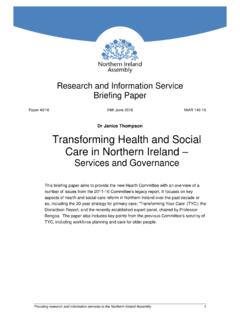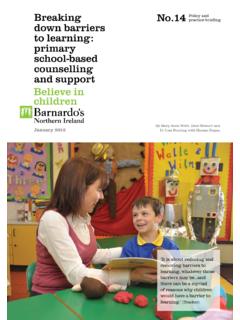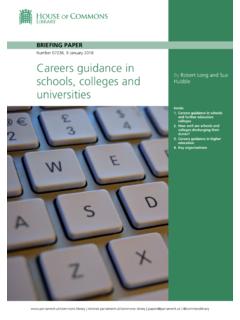Transcription of Background paper on Waste Management in Northern Ireland
1 Providing research and information services to the Northern Ireland Assembly research and information Service briefing paper 1 paper 10/17 17 November 2016 NIAR 435-16 Suzie Cave Background paper on Waste Management in Northern Ireland 1 Introduction As requested, the intention of this paper is to provide Background information to the Committee in relation to the policy framework for Waste Management in NI and an overview of responsibilities. The paper provides an overview of policy drivers, including a brief consideration of targets, figures and trends. It gives an account of the split of responsibilities across central and local government in NI, including cross border responsibilities. It also considers the regulation of cross border Waste movement and highlights a number of measures used to address unauthorised Waste activity.
2 Finally, it offers a number of potential considerations for which the Committee may be interested in seeking further information or clarification from the Department. NIAR 435-16 briefing paper Providing research and information services to the Northern Ireland Assembly 2 Contents 1 Introduction .. 1 2 Policy drivers .. 3 EU .. 3 NI .. 4 Primary legislation .. 4 Secondary legislation .. 5 NI Waste Management Strategy .. 5 Targets, figures and trends .. 6 Waste Management plans .. 9 Waste Prevention Programme .. 10 3 Waste Management responsibilities .. 11 Cross border 12 4 Regulation of cross border Waste movement .. 14 Unauthorised Waste activity .. 15 5 Potential Considerations .. 19 Annex 1: What is resource efficiency and the circular economy?
3 24 Annex 2: Key recommendations from the Mills Review .. 26 NIAR 435-16 briefing paper Providing research and information services to the Northern Ireland Assembly 3 2 Policy framework The following section gives an overview of the main policy drivers for Waste Management in NI. It details the broad legislative context from the European Union (EU) and national legislation, and considers how these are brought together to provide the main framework for an integrated Waste Management network in Northern Ireland . EU The EU influences the implementation and delivery of Waste Management and legislation in Northern Ireland . Examples of key EU Waste directives and regulations include, and are not limited to: 2008/98/EC Waste Framework Directive 1999/31/EC Directive on the Landfill of Waste 2004/12/EC Directive on Packaging and Packaging Waste 2012/19/EC Directive on Waste Electrical and Electronic Equipment 2000/53/EC Directive on the End-of Life vehicles 2006/66/EC Directive on Batteries and Accumulators 2010/75/EC industrial Emissions Directive 2001/42/EC Strategic Environmental Assessment Directive 2001/689/EEC Directive on hazardous Waste 97/11/EC Environmental Impact Assessment Directive 2004/35/EC Environmental Liability Directive 1986/28/EC Sewage Sludge Directive 2006/21/EC Mining Waste Directive Resource Efficiency Roadmap New Circular Economy Package and Action Plan.
4 WFD The Waste Framework Directive (WFD) provides the overarching framework for all Member States in relation to Waste Management and includes definitions of Waste , sets a hierarchy for Waste Management , introduces the polluter pays principle and extended producer responsibility and sets recycling targets. It requires Member States to have in place a Waste strategy and Waste Management plans reflecting its requirements, both of which must be revised every six years. NIAR 435-16 briefing paper Providing research and information services to the Northern Ireland Assembly 4 Circular Economy Package The European Commission adopted an ambitious Circular Economy Package1 (see Annex 1 for definition of the circular economy) consisting of a new EU Action Plan for the Circular Economy2. The new package covers the full economic cycle, not just Waste reduction targets.
5 It includes revised legislative proposals on Waste , and indicators and incentives to business and consumers to help stimulate Europe's transition towards a circular economy. These include: A common EU target for recycling 65% of municipal Waste by 2030; A common EU target for recycling 75% of packaging Waste by 2030; A binding landfill target to reduce landfill to maximum of 10% of municipal Waste by 2030; A ban on landfilling of separately collected Waste ; Promotion of economic instruments to discourage landfilling; Simplified and improved definitions and harmonised calculation methods for recycling rates throughout the EU; Concrete measures to promote re-use and stimulate industrial symbiosis - turning one industry's by-product into another industry's raw material; Economic incentives for producers to put greener products on the market and support recovery and recycling schemes ( for packaging, batteries, electric and electronic equipment, vehicles).
6 Northern Ireland Many EU requirements are written into national legislation; however, Waste is a devolved matter therefore NI can also make its own legislation specific to local needs. This means that not all Waste legislation in NI is directly tied to an EU requirement. Examples of both primary and secondary legislation include, and are not limited to the following: Primary legislation Waste and Contaminated Land ( Northern Ireland ) order 1997 (as amended) Waste and Emissions Trading Act 2003 Environment ( Northern Ireland ) Order 2002 (as amended) Producer Responsibility Obligations ( Northern Ireland ) Order 1998 (as amended) Litter ( Northern Ireland ) Order 1994 Clean Neighbourhoods and Environment ( Northern Ireland ) Act 2011 Environmental Better Regulation Act. 1 Circular Economy Package 2 Action Plan :52015DC0614 NIAR 435-16 briefing paper Providing research and information services to the Northern Ireland Assembly 5 Secondary legislation Waste Management Licensing regulations ( Northern Ireland ) The Waste Regulations ( Northern Ireland ) 2011 The Landfill Allowances Scheme (Amendment) Regulations ( Northern Ireland ) 2011 The Landfill ( Northern Ireland ) Regulations, 2003 (as amended) The Landfill (Amendment) Regulations ( Northern Ireland ) 2011 Food Waste Regulations 2015 which prohibits food Waste sent to landfill since April The WFD requires Member States to have in place a Waste strategy and Waste Management plans.
7 In response to the WFD, NI produced Waste Management strategies in 2000, 2006 and again in 2013. These strategies, together with the three sub-regional Waste Management plans, provide the Waste Management framework for NI. These are detailed in the following subsections. NI Waste Management Strategy The Waste Management strategy (2013) - Delivering Resources Efficiency 4- sets the policy framework for the Management of Waste in Northern Ireland . This is a revised Strategy which retains the core principals of the 2006 Strategy while incorporating the Waste Management Hierarchy of the WFD (Fig 1). Figure 1: Waste Management Hierarchy of the WFD Source: European Commission5 3 4 DAERA (2013) NI Waste Strategy 2013. Available at 5 EC, Directive 2008/98/EC on Waste ( Waste Framework Directive).
8 Available at NIAR 435-16 briefing paper Providing research and information services to the Northern Ireland Assembly 6 Prevention = Avoidance, reduction and re-use; using less hazardous materials Preparing for re-use = Checking, cleaning, refurbishing, repairing whole items or spare parts. Recycling = Turning Waste into a new substance or product. includes composting if it meets quality protocols. Recovery = Anaerobic digestion, incineration with energy recovery, gasification and pyrolysis which produce energy (fuels, heat and power) and materials from Waste . Some backfilling operations. Disposal = Landfill and incineration without energy recovery The old NI Strategy (2006) focused on Waste or resource Management , this means using resources in a way that reduces the quantities of Waste produced, and where Waste is generated, to manage it in a way that minimises its impact.
9 It therefore lacked significant emphasis on prevention (and minimisation at source) preparing for re-use and recycling and was subsequently revised in 2013. This was with the view of to creating a strategic shift in focus away from resource Management , to a renewed focus on resource efficiency. According the NI Strategy, resource efficiency is using resources in the most efficient way while minimising the impact of their use on the environment. 6 This corresponds with the concept of the circular economy which in broad terms means the re-use of Waste as a resource that can be put back into the production loop. With this in mind the 2013 Waste Strategy has a strong emphasis on both concepts. For more information on resource efficiency, the circular economy and impacts, see Annex 1. Targets, figures and trends Waste generated: Total local authority collected (LAC) municipal waste7 in Northern Ireland (April to June 2016) was 262,883 tonnes, a increase on the same period in 2015 (254,007 tonnes).
10 8 Recycling rate: Both the revised NI Strategy and last Programme for Government (2011-2015)9 proposed a target of 45% recycling rate for household Waste by 2015, so as to help contribute towards the EU statutory target of 50% by 2020. However NI just 6 DAERA (2013) NI Waste Strategy 2013. Available at 7 Municipal Waste is defined by DAERA as all of the Waste from households ( of municipal Waste is household Waste ) and also includes Waste collected from civic amenity sites and some commercial Waste . Northern Ireland Environmental Statistic Report (March 2016) 8 DAERA (2016) Northern Ireland Local Authority Collected Municipal Waste Management Statistics Quarterly provisional estimates for April to June 2016. 9 PFG 2011-2015 NIAR 435-16 briefing paper Providing research and information services to the Northern Ireland Assembly 7 fell short of this target by achieving a recycling rate (including composting) of 42% for household Waste in 2014 Most recent statistics for April to June 2016 show the recycling rate for household Waste increased to The current recycling rate for municipal Waste is With this in mind, the revised strategy also provides for the possibility of an ambitious 60% recycling rate of local authority collected municipal Waste by 2020.













